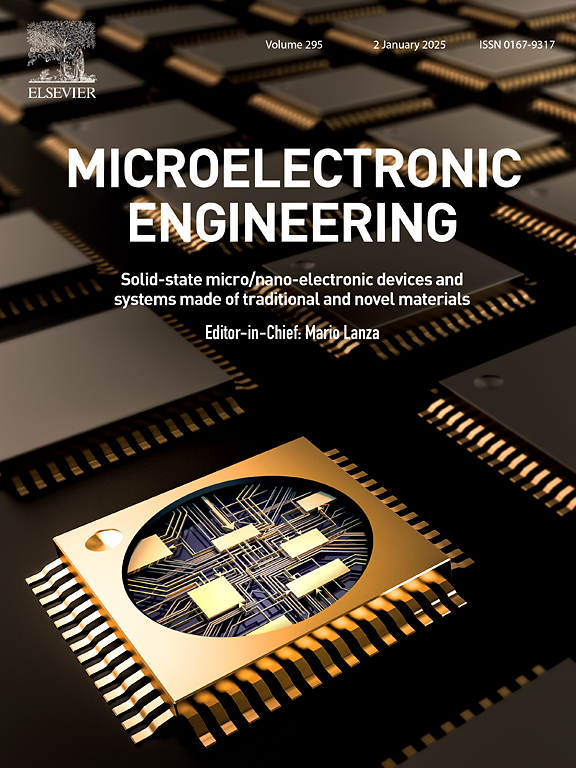Etching of tungsten via a combination of thermal oxide formation and wet-chemical oxide dissolution
IF 3.1
4区 工程技术
Q2 ENGINEERING, ELECTRICAL & ELECTRONIC
引用次数: 0
Abstract
In this work, an etching process for the controlled and partial recess of tungsten metal was developed. The process comprises two steps which can be repeated: a thermal oxidation of the tungsten followed by the oxide dissolution in an acidic or basic solution. During the first step the W metal is heated in the presence of O3 gas in the temperature range of 210–290 °C forming a WO3 oxide. During the second step this thermally grown oxide is then selectively dissolved towards the underlying W metal. Both NH4OH and H3PO4 were down selected as the best wet chemical dissolution agents in terms of dissolution rate and selectivity. By utilizing this combined thermal/wet-chemical cyclic etch process, the total W recess can be tuned on the nanoscale based on oxidation temperature and total number of cycles. This process was then applied for the deep recess (∼180 nm) of narrow (∼20 nm) tungsten trenches for the fabrication of the bottom contacts in complementary field-effect transistors (CFET).

通过热氧化物形成和湿化学氧化物溶解相结合的方法对钨进行蚀刻
本文研究了钨金属可控凹槽和局部凹槽的刻蚀工艺。该工艺包括两个可重复的步骤:钨的热氧化,然后在酸性或碱性溶液中溶解氧化物。在第一步中,W金属在O3气体的存在下,在210-290℃的温度范围内加热,形成WO3氧化物。在第二步中,这种热生长的氧化物被选择性地溶解到下面的W金属中。在溶解速率和选择性方面,确定了NH4OH和H3PO4为最佳湿法化学溶解剂。利用这种热/湿化学循环蚀刻工艺,可以根据氧化温度和循环次数在纳米尺度上调整W的总凹槽。然后将该工艺应用于深凹槽(~ 180nm)窄(~ 20nm)钨沟槽中,用于制造互补场效应晶体管(cet)的底部触点。
本文章由计算机程序翻译,如有差异,请以英文原文为准。
求助全文
约1分钟内获得全文
求助全文
来源期刊

Microelectronic Engineering
工程技术-工程:电子与电气
CiteScore
5.30
自引率
4.30%
发文量
131
审稿时长
29 days
期刊介绍:
Microelectronic Engineering is the premier nanoprocessing, and nanotechnology journal focusing on fabrication of electronic, photonic, bioelectronic, electromechanic and fluidic devices and systems, and their applications in the broad areas of electronics, photonics, energy, life sciences, and environment. It covers also the expanding interdisciplinary field of "more than Moore" and "beyond Moore" integrated nanoelectronics / photonics and micro-/nano-/bio-systems. Through its unique mixture of peer-reviewed articles, reviews, accelerated publications, short and Technical notes, and the latest research news on key developments, Microelectronic Engineering provides comprehensive coverage of this exciting, interdisciplinary and dynamic new field for researchers in academia and professionals in industry.
 求助内容:
求助内容: 应助结果提醒方式:
应助结果提醒方式:


